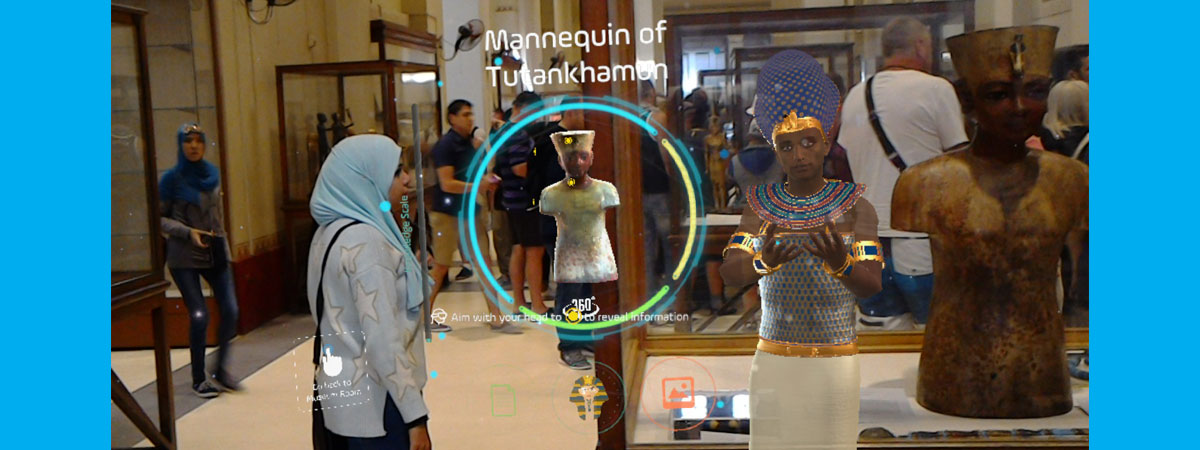
Using an augmented reality headset, visitors to Cairo’s famous Egyptian Museum will have King Tut as their tour guide thanks to researcher Ramy Hammady
THE most famous artefacts of ancient Egypt have been described to Cairo museum-goers by the ultimate expert – Tutankhamun.
This is thanks to innovations in augmented reality (AR) made by a researcher at the University of Huddersfield. And one of the first to sample his new system was a direct descendent of the English aristocrat who famously bankrolled the 1920s archaeological dig that rediscovered the 3,000-year-old treasures of King Tut’s tomb.
Egyptian-born Ramy Hammady – studying for his doctorate – is developing a system that he has named MuseumEye. Incorporated into Microsoft’s HoloLens AR headset, it enriches the museum experience.
Ramy’s animation skills and the specialist collaborations he has formed with other University of Huddersfield researchers have resulted in a prototype that has been successfully trialled at Cairo’s Egyptian Museum, repository for the fabulous treasures found in the tomb of Tutankhamun, the boy pharaoh who died circa 1323 BC.
The museum was seeking ways to enhance the experience of visitors, and gave the go-ahead for an eight-day trial of Ramy’s MuseumEye prototype, which was sampled by 171 participants, including several of the museum’s curators.
The headset combines the physical environment – such as a museum room and its exhibits - with a 3D virtual space.
“Imagine you are a visitor to the Egyptian Museum, arriving at the central exhibit – Tutankhamun,” explains Ramy. “Wearing the headset transforms the room into the Pharaoh’s temple, where he introduces himself and demonstrates his power and riches. The headset has a futuristic floating user interface with options of what to look at as the Pharaoh guides you around his palace.”
In order to create his 3D virtual space and its antiquities, Ramy was able make scans of replicas – produced for the Egyptian government – of the some of the treasures of Tutankhamun, including his throne. This means that visitors using MuseumEye can inspect the artefacts from all angles via the headset.
Ramy himself created the animated figure of Tutankhamun that appears in MuseumEye, and the Pharaoh’s voice (speaking in English so far, although languages including Arabic will follow) was synthesised in the University of Huddersfield’s studios by doctoral researcher Sebastien Lavoie, whose PhD deals with electroacoustic and electronic music.
 Researcher Ramy Hammady
Researcher Ramy HammadyMuseumEye
When MuseumEye was tested in the Egyptian Museum, it was found that visitors who used the headset spent between five to seven minutes in front of exhibits, instead of the five to 15 seconds that is typical without AR interaction.
One of the visitors who sampled the system was the current Earl of Carnarvon, great grandson of the wealthy aristocrat who was financial backer of the Egyptologist Howard Carter’s excavation of Tutankhamun's tomb in the Valley of the Kings.
“He was invited by the museum management to try the system and he was very happy with it,” said Ramy, who is now in the final stages of his PhD research and will continue to refine MuseumEye.
He is keen to try it out at the Manchester Museum, which has a noted Egyptian display, including a representation of one of the battles fought by the armies of Tutankhamun.
Ramy studied for his first degrees – including a Master’s dealing with 3D anaglyph glasses – in his native Egypt. Moving on to doctoral research, he relocated first to the University of Huddersfield – because of its expertise in virtual and augmented reality – and is now completing his project at the University of Staffordshire.
In addition to developing MuseumEye, he is also part of the team at the major University of Huddersfield-based research centre None in Three, which is developing computer games that will address issues of domestic violence in a wide range of countries.
More News
Game enterprise national competition first prize
Computer Games Design graduate Rob Potter’s This Dead Winter stole the show at the PC Indie Pitch
VR game enterprise 2nd national prize in 6 months
Virtual reality game Hyper Party Ware VR wins Shuttershade Studios a US$3,000 marketing package
Fine Art grad makes his mark at national exhibitio
Frank To, who graduated in 2004, attributes his success on the national stage to his Huddersfield degree
